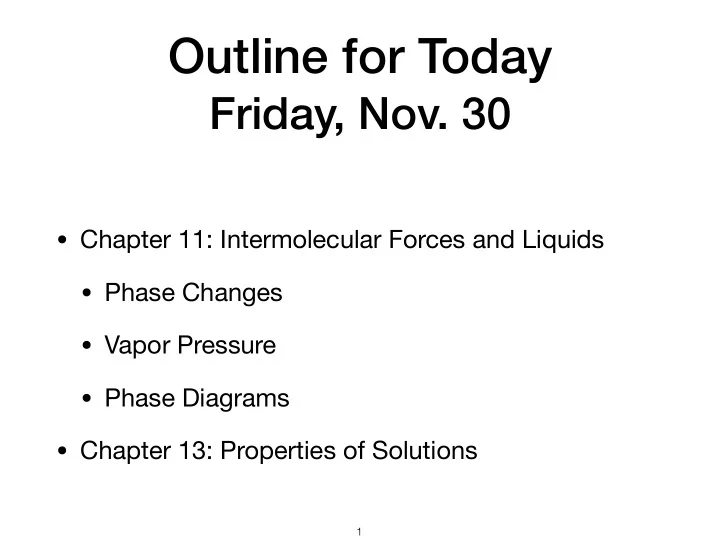

Outline for Today Friday, Nov. 30 • Chapter 11: Intermolecular Forces and Liquids • Phase Changes • Vapor Pressure • Phase Diagrams • Chapter 13: Properties of Solutions � 1
Phase Changes
Heating Curves and Phase Changes
Example Problem: Enthalpy of Phase Changes • How much heat is required to convert 100. g of ice that is at -10 o C to steam at 120 o C? Heat for Phase Changes Heat for Changing Temperature C p ice 4.19 J/(g K) ∆ H fus 333.55 J/g C p liquid water 4.18 J/(g K) ∆ H vap 2257 J/g C p steam 2.00 J/(g K)
Vapor Pressure • Vapor Pressure: the partial pressure of the vapor when it is in dynamic equilibrium with the liquid • Dynamic Equilibrium: Two opposing processes occur simultaneously at equal rates gas ➞ liquid At equilibrium, both processes are happening at the same time! liquid ➞ gas
Dynamic Equilibrium and Vapor Pressure
Volatility Gas • Volatility: How easily a liquid evaporates. phase transition • A molecule is more volatile and has a higher vapor pressure if it has weaker intermolecular forces . LIQUID
Volatility Examples • Why does hot water evaporate more quickly than cold water? • Why does liquid nitrogen evaporate more quickly than water?
How do Vapor Pressure and Boiling Point Relate? Read the chart to rank the molecules by increasing vapor pressure at a given temperature. No Chart? Rank the molecules by IMF Rank the molecules by Boiling Point. The lower the boiling point, the higher the vapor pressure!
How do Vapor Pressure and Boiling Point Relate? Clausius-Clapeyron Equation · 1 ln( P ) = − ∆ H vap T + C R
Phase Diagrams
Phase Diagrams: How To Read Them Given two independent variables: P and T… what is the dependent variable, the phase or state of matter?
Phase Diagram for CO 2
Phase Diagram for H 2 O
Recommend
More recommend